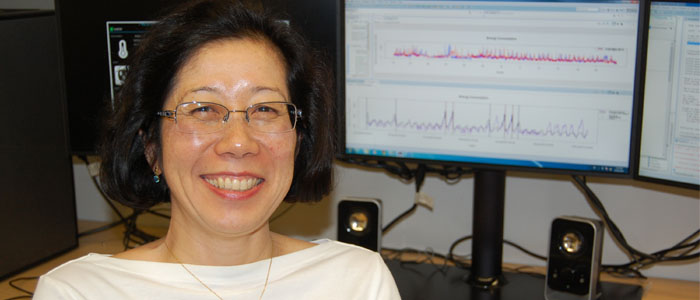Media
Contact
Communications Specialist
Faculty of Engineering
Spencer Engineering Building
Room 2072
Western University
Tel: 519-661-2111 ext. 87015
Email: engineeringcomms@uwo.ca
Creating ‘smart,’ sustainable buildings

Western Engineering News | July 9, 2014
Imagine controlling the temperature in your office without lifting a finger. Electrical and Computer Engineering associate professor feels we are not far off from the reality of building smarter, more sustainable buildings.
Data-driven building resource management solutions for large institutions, such as Western University and the London Health Sciences Centre, means big savings for the organizations. Through the use of Big Sensor Data, Capretz is developing a cloud-based platform to help create 'smart' buildings.
We are in the era of cyber-physical systems, she says, noting that, “a huge number of devices connected to the physical world can be interconnected and share information with each other.”
The advantage of this data collection is that when it comes to resource management in buildings, “these devices could be monitored and provide valuable real-time information”.
“We can analyze data and do prediction modelling… and support the maintenance of buildings.”
Recent advances in software and cloud computing, as well as improvements in wireless communication and the prevalence of sensor data, are redefining building management.
In ‘smart buildings,’ computational resources are constructed to manage, optimize and reduce their own energy and other resources consumption based on the data being collected by sensors.
“We are using cloud technology to store data. With real-time data, we are designing and developing models based on the data to perform actions such as detecting anomalies,” she says.
Use of this sensor data can eliminate human error. The data can be captured in real time and the building’s intelligence would allow for an automated response addressing the energy concern or improving performance.
The more data collected, the more accurate the building’s response will be, as the high volume of data will train the models to generate an appropriate response.
“The goal is to see buildings built in a different way,” she says.
Capretz’s research involves developing a cloud-based platform to provide sustainable management applications to help organizations advance their sustainability initiatives, by controlling costs, managing resources for better performance. This could be related to discovering energy consumption patterns, predicting future energy consumption, and suggesting courses of action.
For example, Capretz has been working with Brampton-based green energy product line company, Powersmiths, to develop a cloud-based software platform for a comprehensive building resource management for advanced and innovative sustainability initiatives.
“We analyze buildings data and improve their performance and proactive maintenance.”
Members of her team are also working on a mobile application to record an individual’s energy consumption within communities. This is based on gaming techniques, which allows a person to track his or her energy consumption towards achieving goals; hence sustainability actions.
“The app would engage users to keep doing more actions,” she says. “Hopefully you will be more conscientious about energy consumption.”
This kind of application would also be useful for facilities managers who want to see a building’s energy consumption in real time.
Capretz also notes the broader application of such technology to address other sustainability initiatives. For example, sensor data collected from smart cars and parking lots in large cities could be used for traffic control by transmitting information to a driver looking for an available parking space.
It could also be used for personalized health-care treatments.
In the world of ‘Big Data,’ Capretz is cognizant of the importance of ethical data management and analytics. Her research also explores security and privacy issues.
“It is not just collecting data,” she explains. “How are we going to use it and how do we collect it properly to generate valuable information from the Big Data?”

